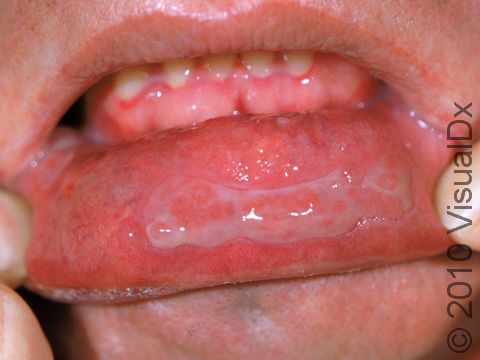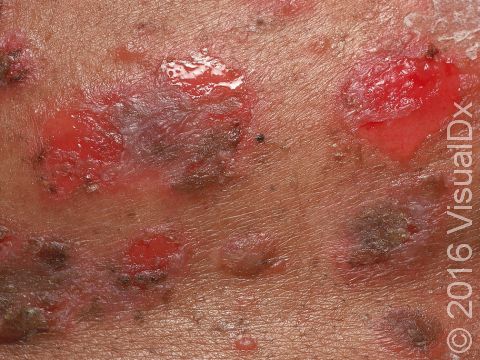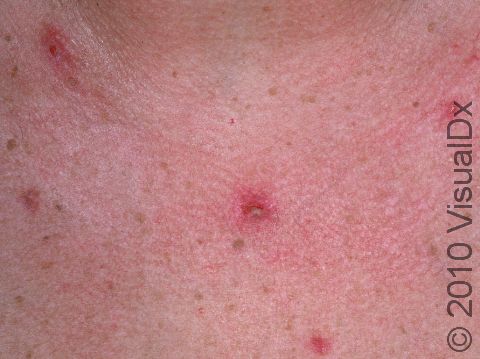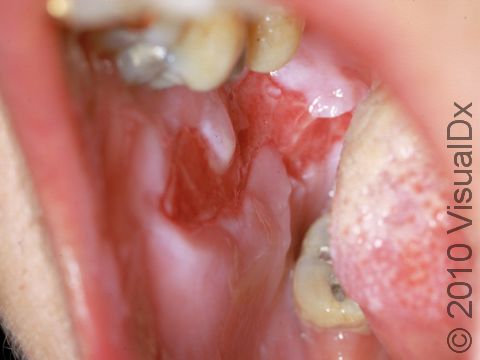Pemphigus Vulgaris
Pemphigus vulgaris (PV) is an autoimmune disease of the skin and mouth (mucous membrane). Autoantibodies attack molecules that essentially hold the skin cells together, causing them to separate and resulting in blisters. Pemphigus vulgaris is characterized by multiple lesions or blisters that do not heal, or that recur and spread to larger portions of the body. As many as 80% of the cases first exhibit symptoms in the mouth, and the mouth is sometimes the only site of lesions.
Typically, those with pemphigus vulgaris will have multiple ulcers that persist for weeks to months. Blistering may be accompanied by severe pain, itching, burning, and stinging. If extensive, blistering can lead to life-threatening fluid loss, infection, and disfigurement. Fatalities from pemphigus vulgaris are extremely unlikely in the United States; however, timeliness of treatment is critical.
Pemphigus vulgaris is categorized as an ultra-rare disease, and, consequently, as many as 80% of cases are misdiagnosed for an average of 6 months. With treatment, lesions can heal normally without scarring. Most patients treated for pemphigus will enter a partial or full remission within 2–5 years.
Who's At Risk?
Pemphigus vulgaris affects men and women approximately equally. Although sometimes appearing in younger people, the average onset of symptoms is in those aged 50–60 years. Pemphigus vulgaris can occur in persons of any ethnicity, but the disorder tends to appear more often in persons of Mediterranean ancestry, Ashkenazi Jews, and some subtypes in people from Brazil and Colombia.
Pemphigus vulgaris is categorized as an ultra-orphan disease (meaning it is very rare), affecting approximately 10,000–30,000 people in the United States.
Signs & Symptoms
Eighty percent of the time, symptoms begin in the mouth, with soft (flaccid) blisters or erosions, and these symptoms are often mistaken for other conditions of the mouth. Two-thirds of those affected with pemphigus vulgaris eventually experience lesions on both the skin and in the mouth. If left untreated, the erosion/blisters gradually spread over an increasing surface area and can be complicated by severe infections, metabolic disturbances, or fluid loss.
Self-Care Guidelines
Self-care measures for pemphigus vulgaris are as follows:
- Keep wounds clean – Be very gentle and do not use harsh cleansers.
- If bandaging is necessary, use bandages that provide moisture and protection, or keep the skin moist with sterile lotions. Silicone bandages, such as those used in burn centers, can be useful. Bandages should allow for airflow but protect against contaminants.
- Avoid touching ointment and bandages.
- Do not use bandages that are dry or stick to your skin.
- Avoid spicy foods (eg, garlic and onions) and nuts, which may help relieve symptoms.
- Antibiotic ointment or cream can help treat infection – An antibiotic that includes a local painkiller can bring some relief of pain associated with pemphigus vulgaris.
- Oral rinses and ointments can be used to reduce pain in the mouth.
Be sure to ask your doctor for advice on dealing with the side effects of corticosteroids and other immune suppressants.
Treatments
A confirming diagnosis for pemphigus vulgaris is accomplished through a biopsy of the skin or the inner lining of the mouth (oral mucosa). The tissue specimen is sent for a test called direct immunofluorescence. After a diagnosis is made, treatment begins with a period of intense therapy with corticosteroids (eg, prednisone) in an effort to gain control and suppress disease activity until no new lesions appear. The duration of this phase ranges from several weeks to months. Often, a second medication is added to allow lower doses of the corticosteroid and reduce associated side effects.
After all lesions heal, medications can gradually be tapered, aiming for the lowest dose that prevents new “flares” of lesions from appearing.
If pemphigus vulgaris fails to respond to corticosteroids, result in unacceptable side effects, or is extensive or progressing rapidly, your doctor may add an immunosuppressant, IVIg treatment, plasmapheresis, or biologic agents.
Visit Urgency
It is very important to get an accurate confirming diagnosis as soon as possible, so see your doctor if you display any of the signs or symptoms discussed here or suspect you might have pemphigus vulgaris. Early expert diagnosis is important, as pemphigus vulgaris – as with other autoimmune diseases – becomes more resistant to treatment if it is not promptly and appropriately controlled.
Last modified on October 5th, 2022 at 7:46 pm

Not sure what to look for?
Try our new Rash and Skin Condition Finder





